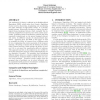Free Online Productivity Tools
i2Speak
i2Symbol
i2OCR
iTex2Img
iWeb2Print
iWeb2Shot
i2Type
iPdf2Split
iPdf2Merge
i2Bopomofo
i2Arabic
i2Style
i2Image
i2PDF
iLatex2Rtf
Sci2ools
GECCO
2007
Springer
2007
Springer
Crossover: the divine afflatus in search
The traditional GA theory is pillared on the Building Block Hypothesis (BBH) which states that Genetic Algorithms (GAs) work by discovering, emphasizing and recombining low order schemata in high-quality strings, in a strongly parallel manner. Historically, attempts to capture the topological fitness landscape features which exemplify this intuitively straight-forward process, have been mostly unsuccessful. Population-based recombinative methods had been ly outperformed on the special designed abstract test suites, by different variants of mutation-based algorithms. Departing from the BBH, in this paper we seek to exemplify the utility of crossover from a different point of view, emphasizing the creative potential of the crossover . We design a special class of abstract test suites, called Trident functions, which exploits the ability of modern GAs to mix good but significantly different solutions. This approach has been so far neglected as it is widely believed that disruption caused...
| Added | 16 Aug 2010 |
| Updated | 16 Aug 2010 |
| Type | Conference |
| Year | 2007 |
| Where | GECCO |
| Authors | David Iclanzan |
Comments (0)

